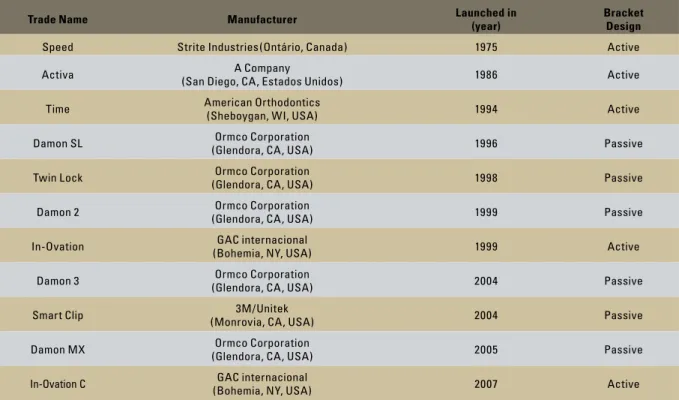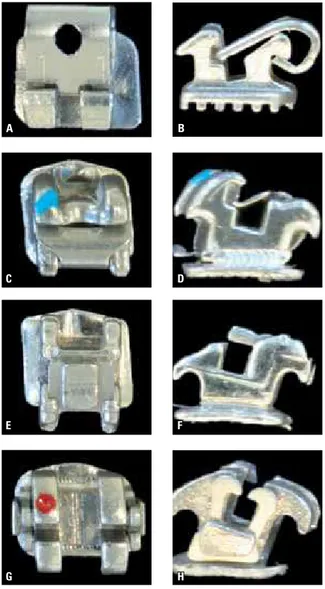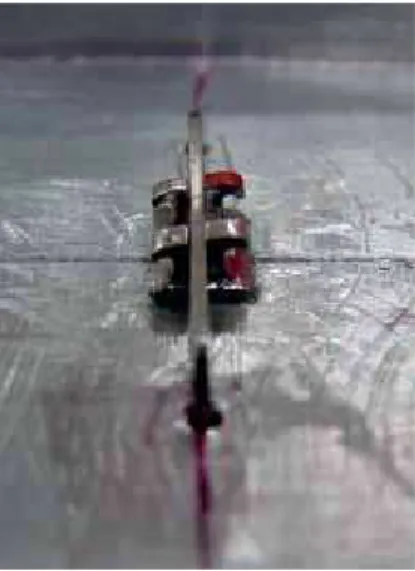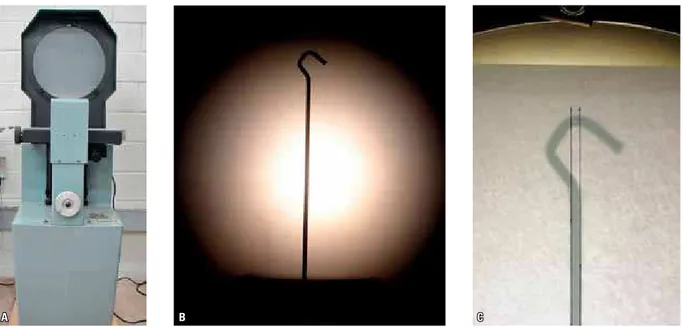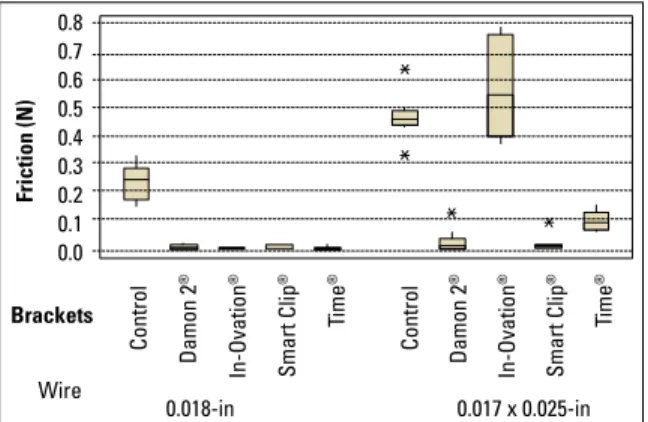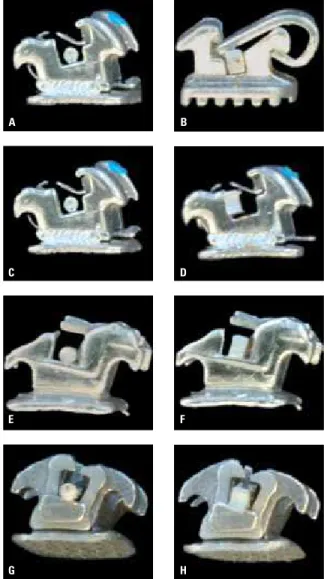Evaluation of friction in self-ligating brackets
subjected to sliding mechanics: an in vitro study
Mariana Ribeiro Pacheco*, Dauro Douglas Oliveira**, Perrin Smith Neto***, Wellington Correa Jansen****
Introduction: Friction generated at the bracket/archwire interface during sliding
mechan-ics can reduce the efficiency of orthodontic movement. The ligation method employed to tie the archwire to the bracket plays an important role in determining this friction. Meth-ods: This study compared the frictional force generated by four different types of
self-ligating brackets (Time®, Damon 2®, In-Ovation R® and Smart Clip®) with a group of
con-ventional orthodontic brackets (Dynalock®) that require the use of traditional elastomeric
ligatures (ExDispens-A-Stix®), which served as the control group. Static friction force was
measured using an EMIC DL® 500 universal testing machine using stainless steel round
0.018-in and rectangular 0.017x0.025-in archwires. Results: ANOVA and Tukey’s test
showed low levels of friction in the four self-ligating brackets in tests with the 0.018-in wire (P <0.05). However, the results noted when the self-ligating brackets were tested us-ing 0.017x0.025-in archwires showed high resistance to slidus-ing in the self-ligatus-ing groups. Abstract
Abstract: Friction. Orthodontic brackets. Self-ligating brackets. Sliding mechanics.
* MSc in Orthodontics, Pontiical Catholic University (PUC) Minas, Belo Horizonte / Minas Gerais State.
** MSc in Orthodontics, Marquette University, Milwaukee, USA. PhD in Orthodontics, UFRJ, Rio de Janeiro/RJ. Coordinator, MSc Course in Orthodontics, Pontiical Catholic University (PUC) Minas, Belo Horizonte/Minas Gerais State.
*** MSc in Mechanical Engineering, University of São Paulo/SP. PhD in Mechanical Engineering, University of São Paulo/SP and Universitat Stuttgart/Germany. Postdoctorate, University of British Columbia, Vancouver, Canada.
**** MSc in Prosthodontics, USP, Bauru. PhD in Dental Materials, USP, São Paulo/SP. Adjunct Professor, Pontiical Catholic University (PUC) Minas, Belo Hori
-zonte / Minas Gerais State. IntRoductIon
The presence of friction in orthodontic slid-ing mechanics poses a clinical difficulty to ortho-dontists since high levels of friction reduce the effectiveness of mechanics, affecting the rate of tooth movement and rendering anchorage control difficult. Under these circumstances, orthodontic treatment becomes more complex.4
The search for ideal conditions to conduct orthodontic therapy involves reducing the
fric-tional force created at the bracket/wire/ligature interface.12 This would imply the use of lighter
forces, but still sufficient to promote tooth move-ment. Thus, there will be increased biological compatibility and less patient discomfort.
According to Rossouw,14 friction is a force that
needed to start a movement between solid objects at rest. Moreover, kinetic friction force resists the sliding motion of a solid object against another at a constant speed.11 Kinetic friction is always smaller
than static friction since it is more difficult to draw a body from a resting position than to perpetuate its movement.11 In orthodontics, a tooth subjected
to sliding motion along the archwire is alternately inclined and uprighted, moving in small incre-ments.10 Therefore, space closure depends more on
static than kinetic friction.
Among the numerous attempts to reduce fric-tion by changing bracket design, the concept be-hind so-called self-ligating brackets, i.e., requiring no ligature to tie the orthodontic archwire, first emerged in 1935 with the Russell Lock appliance. Since then, other appliances have been developed along the same line (Table 1).
Self-ligating brackets are orthodontic appli-ances that do not require ligatures to hold the wire
in the bracket slot thanks to a mechanical device built into their buccal surface, which closes the bracket slot, thereby preventing the archwire from disengaging. Some self-ligating bracket systems do not push the orthodontic archwire against the in-ner wall of the slot and are appropriately called passive self-ligating appliances.1,2 In these
appli-ances the cap or cover simply creates a barrier to keep the archwire inside the slot. With the intro-duction of active self-ligating bracket systems, the slot cover might or might not apply pressure onto the archwire depending on archwire diameter.1,2
This study aimed to: 1) Assess the static fric-tion force delivered in passive and active self-li-gating brackets when using stainless steel round 0.018-in orthodontic archwires, and 2) assess the static friction force delivered in passive and active self-ligating brackets when using stainless steel rectangular 0.017x0.025-in orthodontic arch-wires during in vitro sliding mechanics simulation.
TABLE 1 - Development of self-ligating brackets.
Trade Name Manufacturer Launched in (year) Bracket Design
Speed Strite Industries(Ontário, Canada) 1975 Active
Activa (San Diego, CA, Estados Unidos)A Company 1986 Active
Time American Orthodontics
(Sheboygan, WI, USA) 1994 Active
Damon SL Ormco Corporation
(Glendora, CA, USA) 1996 Passive
Twin Lock Ormco Corporation
(Glendora, CA, USA) 1998 Passive
Damon 2 Ormco Corporation
(Glendora, CA, USA) 1999 Passive
In-Ovation GAC internacional
(Bohemia, NY, USA) 1999 Active
Damon 3 Ormco Corporation
(Glendora, CA, USA) 2004 Passive
Smart Clip 3M/Unitek
(Monrovia, CA, USA) 2004 Passive
Damon MX (Glendora, CA, USA)Ormco Corporation 2005 Passive
In-Ovation C GAC internacional
A
C
E
G
B
D
F
H
Methodology Material
Four types of self-ligating brackets were evalu-ated, two active systems—Time 2® (American
Or-thodontics, Sheboygan, WI, USA) and In-Ovation R® (GAC International, Bohemia, NY, USA)—and
two passive systems—Damon 2® (Ormco
Corpo-ration, Glendora, CA, USA) and Smart Clip® (3M
Unitek, Monrovia, CA, USA) (Fig 1).
The control group used conventional stainless steel orthodontic brackets (Dynalock®,
3M/Uni-tek, Monrovia, CA, USA) tied with conventional grey-colored elastomeric ligatures (Dispens-A-Stix®, TP Orthodontics, La Porte, IN, USA).
All brackets were for maxillary central incisors with 0.022x0.028-in slot in Roth prescription (5º angulation and 12° torque). Since Smart Clip®
ap-pliances are not available in Roth prescription, MBT brackets—with 4° angulation and 17º torque—were used instead, given their close similarity.
Stainless steel round 0.018-in and rectangular 0.017x0.025-in archwires (3M / Unitek, Monro-via, CA, USA) were employed in the tests. There were altogether 20 units of each type of bracket. Ten were tested using the round archwires and the other ten, rectangular archwires. Each sample, comprising bracket/wire, was subjected to five consecutive tests in order to increase the reliabil-ity of results, totaling 400 tests.
Methods
To assess friction force, the authors used an EMIC DL 500 universal testing machine (EMIC Equipamentos e Sistemas de Ensaio Ltda., São José dos Pinhais, PR, Brazil), which belonged to the Laboratory of Structural Analysis, Department of Mechanical Engineering, Pontifical Catholic University (PUC), Minas. A 5N load cell was used, with a speed of 1 mm/min (Fig 2A). The results pertaining to static friction force were transmitted to a computer connected to the testing machine.
To simulate sliding mechanics, a straight line static traction test was implemented while each bracket remained at rest relative to its base and the wire slid along the bracket slot. To this end, an aluminum device was fabricated, which was con-nected to the load cell through grippers. This de-vice contained two plates, i.e., a lower plate where brackets were bonded, and which remained mo-tionless, and an upper plate, connected to the orthodontic wire segment of the test specimen undergoing displacement (Fig 2B).
FIGURE 1 - Self-ligating brackets tested in this study: Time 2® in (A)
front and (B) lateral view; In-Ovation R® in (C) front and (D) lateral view;
Damon 2® in (E) front and (F) lateral view; Smart Clip® in (G) front and
A B
All test specimens were prepared by the same operator. The brackets and wires were cleaned with 70% ethyl alcohol so as to keep them free of grease or dirt that might interfere with the results. Bracket bonding was performed using instant cya-noacrylate ester based adhesive (Super Bonder, Loctite Henkel, SP, Brazil). When positioning the brackets care was taken to keep the bracket base parallel to the aluminum plate.
Bracket placement was standardized with the aid of a U-shaped stainless steel 0.021x0.025-in wire device, which was placed in the bracket slot with its ends fitted into holes in the plate, as can be seen in Figure 3. As the bracket slot and orth-odontic archwire became collinear, as a result of the bonding position, archwire entry angle was equal to zero. These auxiliaries ensured accuracy and reproducibility of bracket placement proce-dure for all specimens. Moreover, it was important in ensuring that the archwire remained passive in the bracket slot prior to ligation. It is known that resistance to friction during tests stems from fric-tion produced by the ligafric-tion method (either elas-tomeric or self-ligating) added to any inclination
between archwire and bracket caused by a non-passive archwire in the bracket slot.8 Therefore, in
order that only the friction produced at the brack-et/wire or brackbrack-et/wire/ligature interface could be measured, the archwire was passively aligned, i.e., with no angulation inside the slot.
The segment of orthodontic wire used in the specimens was 3 cm in length. At its upper end a standard hook was fashioned, which was fitted onto the upper plate of the device. Each wire segment was evaluated using a profile projector (Micro VU Model H14, São Paulo, Brazil) (Fig 4). The aim of this evaluation was to standardize wire bends and determine with accuracy the long axis of the wire segment. These factors are im-portant in driving vertical forces applied by the universal testing machine.
When preparing the control group specimens, ligature insertion occurred in a standardized fash-ion. To this end, an elastomeric ligature applica-tion device was used (Straight Shooter® Ligature
Gun, TP Orthodontics, La Porte, IN, USA), which allowed all ligatures to be stretched to the same length at the time of insertion.
A B C
ReSultS
The non-parametric Kruskal-Wallis test dis-closed that even when tests on the same speci-men were repeated up to five times no signifi-cant change occurred in static friction force (p <0.05). Because friction was not influenced by the number of times a test was repeated (i.e., whether it was the 1st, 2nd, 3rd, 4th or 5th test repetition), the mean test results of each speci-men were used to evaluate differences between the materials being tested.
Descriptive analysis showed that rectangular 0.017x0.025-in wires exhibited higher mean fric-tion force than round 0.018-in wires (p<0.05). The bracket In-Ovation R® displayed the
high-est friction values, as shown in Figure 5, but only when testing with rectangular wires.
The least significant difference (LSD) meth-od, at a significance level of p <0.05, was used with the purpose of identifying significant dif-ferences between the combinations used in the study. Comparison between the four types of
self-ligating brackets using the round wires yielded no significant friction force differences (p <0.05). Furthermore, all self-ligating brackets exhibited significantly lower friction force than the control group (Fig 5). The self-ligating brackets showed a friction force approximately 95% smaller than conventional brackets.
Considering the tests using rectangular wire, the brackets In-Ovation R® and Time® showed
friction force levels that were statistically similar to the control group (p<0.05), whereas the groups comprising Damon 2® and Smart Clip® brackets
displayed significantly lower levels of static fric-tion (p<0.05) compared to the control group.
dIScuSSIon
In orthodontics, when teeth undergo sliding mechanics along an archwire, cyclical inclina-tion and uprighting movements occur while displacement develops in small increments.10
orthodontic movement seems to depend more on static friction than kinetic friction, rendering the latter of little relevance in clinical practice.13
Therefore, this study focused on recording stat-ic frstat-iction force only.
As regards the materials tested in this study, no significant relationship was found between up to five test repetitions on the same specimen, and increases in static friction force. Kapur et al,7 however, noted, using scanning electron
mi-croscopy, the presence of changes in the bracket and/or archwire surface, such as scratches and wear on the slot walls and archwire surface, when they twice used rectangular wire seg-ments in titanium or stainless steel brackets. They ascribed increases in friction force to these surface changes. Nonetheless, it is known that interaction between friction resistance and wear resistance is uncertain since this relationship is also influenced by material stiffness.12 In this
study, given the fact that only low friction sys-tems were tested, which entail less interaction between archwire and bracket slot, the influ-ence of possible changes in the bracket surface might not bear any special significance.
FIGURE 5 - Box plot chart showing the frictional force produced by the different brackets and wires in the tests.
All brackets tested in this study had built-in angulation and torque. All brackets were bonded using the stainless steel 0.021x0.025-in device described before. This ensured the same arch-wire entry angle in all brackets, thereby elimi-nating the influence of the built-in angulation. It is known that the higher the torque, the lower the contact between archwire and slot walls. Al-though the Smart Clip® self-ligating brackets had
17º built-in torque and the other brackets 12°, this difference does not seem to have influenced the levels of friction found in this investigation. This may be linked to the fact that the archwires (0.018-in and 0.017x 0.025-in) do not fill the entire bracket slot (0.022x0.028-in).
The results showed that all self-ligating brack-ets exhibited similar friction force levels when tested with round 0.018-in stainless steel arch-wires, with values close or equal to zero. This finding may be related to the fact that there was 0° angulation between archwire and bracket slot walls during the tests. Since the archwire diame-ter was smaller than the slot size, the low friction reflects the absence of normal force.12
When tested with rectangular 0.017x0.025-in archwires, the In-Ovation R® and Time®
brackets showed significantly higher levels of frictional force when compared with Damon 2® and Smart Clip®. This difference may be
as-sociated with the slot ligation system, which is considered active in the former two and passive in the latter two systems. It is known that the passivity of self-ligating brackets is determined by wire gauge (Fig 6).
Some studies5,15,16 comparing passive and
active self-ligating bracket systems found re-sults that resemble those found in this study. According to these investigations, conducted using small diameter wires, no significant dif-ference was found between friction values. However, when rectangular arches were tested, active brackets showed more resistance to slid-ing than passive appliances.
Control Friction (N) Damon 2 ® In-Ovation ®
A
C
E
G
B
D
F
H
FIGURE 6 - Characteristics of the ligation systems of self-ligating brackets. In A, C, E and G, the Time®, In-Ovation R®, Damon 2® and
Smart Clip®, respectively, in tests using a round archwire do not show
contact between ligation system and archwire. B and D show that the ligation systems of Time 2® and In-Ovation R® exert pressure on the
rectangular wire; and F and H show no contact between the ligation system and the archwire when rectangular archwires are used with Damon 2® and Smart Clip®.
In assessing the In-Ovation R® appliance, a
significant friction force discrepancy was found between the use of 0.018-in and 0.017x0.025-in, underscoring the effect its ligation system has on friction, since this effect depends on the presence or absence of contact between ligation system and archwire, the surface structure of the wire, and the normal force exerted by the ligation system. It is
important, however, to consider the angulation of the archwire relative to the bracket slot since this variable was not included in this study, although it significantly affects resistance to sliding.3,17,18
Despite the fact that the In-Ovation R® appliance
exhibited high levels of friction with rectangular wires in certain biomechanical conditions, this can mean an advantage in cases, for example, where the need arises to control torque in posterior teeth.
The results of this study showed that self-ligating brackets produce less friction than con-ventional orthodontic appliances. Since the ef-ficacy of therapy using fixed orthodontic appli-ances depends, among other things, on the force fraction released relative to the applied force, theoretically, one can assert that low levels of friction force could render treatment more ef-fective. However, one of the few studies that compared self-ligating brackets with conven-tional brackets9 during the alignment and
level-ing phase failed to clarify the true implications of these appliances in orthodontic practice. Other important issues involving the use of self-ligating brackets should also be considered, such as possible technical difficulties in handling these brackets, and especially, their higher cost.
Clinicians should be cautious when interpret-ing the results of laboratory studies on friction. In vitro studies on resistance to sliding using straight line static traction applied to the bracket/wire interface do not reflect with complete accuracy the complexity of tooth movement. However, it is still a widely used method of assessment, which may be applied to address issues raised by orthodontists with respect to friction reduction. Jost-Brinkmann and Miethke6 after in vivo and in
1. Berger J. The Speed appliance: a 14-year update on this unique self-ligating orthodontic mechanism. Am J Orthod Dentofacial Orthop. 1994 Mar;105(3):217-23.
2. Damon D. The Damon low-friction bracket: a biologically compatible straight-wire system. J Clin Orthod. 1998 Nov;32(4):670-80.
3. Drescher D, Bourauel C, Schumacher HA. Frictional forces between brackets and arch wire. Am J Orthod Dentofacial Orthop. 1989 Nov;96(5):397-404.
RefeRenceS 4. Frank C, Nikolai R. A comparative study of frictional resistances between orthodontic bracket and arch wire. Am J Orthod Dentofacial Orthop. 1980 Dec;78(6):593-609. 5. Henao S, Kusy R. Evaluation of the frictional resistance
of conventional and self-ligating bracket designs using standardized archwires and dental typodonts. Angle Orthod. 2004 Apr;74(2):202-11.
6. Jost-Brinkmann P, Miethke R. Einluß der physiologischen zahnbeweglichkeit auf die friktion zwischen bracket und bogen. Fortschr Kieferorthop, 1991;52(2):102-9. 7. Kapur R, Sinha P, Nanda R. Frictional resistance in
orthodontic brackets with repeated use. Am J Orthod Dentofacial Orthop. 1999 Oct;116(4):400-4.
concluSIonS
» All self-ligating brackets showed a significant reduction in friction with round 0.018-in archwires and can be considered a clinical al-ternative to minimize the undesirable effects of friction generated by conventional brack-ets when sliding mechanics is employed.
contact address
Mariana Ribeiro Pacheco
Avenida Pereira Teixeira, 100 /203 - Centro CEP: 36.200-034 - Barbacena / MG E-mail: marianarpacheco@yahoo.com
Submitted: December 2007 Revised and accepted: October 2008 8. Khambay B, Millett D, McHugh J. Evaluation of methods of
archwire ligation on frictional resistance. Eur J Orthod. 2004 Jun;26(3):327-2.
9. Miles PG, Weyant RJ, Rustveld L. A clinical trial of Damon 2 vs conventional twin brackets during initial alignment. Angle Orthod.2006;76(3):480-95.
10. Nanda RS, Ghosh J. Biomechanical considerations in sliding mechanics. In: Nanda R. Biomechanics in clinical
Orthodontics. 1st ed. Philadelphia: W. B. Saunders; 1997.
cap. 10, p. 188-217.
11. Omana HM, Moore RN, Bagby MD. Frictional properties of metal and ceramic brackets. J Clin Orthod. 1992 jul;26(7):425-32.
12. Pizzoni L, Ravnholt G, Melsen B. Frictional forces related to self-ligating brackets. Eur J Orthod. 1998;20:283-91. 13. Redlich M, Mayer Y, Harari D, Lewinstein I. In vitro study
of frictional forces during sliding mechanics of
“reduced-friction” brackets. Am J Orthod Dentofacial Orthop. 2003 Jul;124(1):69-73.
14. Rossouw E. Friction: an overview. Seminars Orthod. 2003 Dec;9(4):218-22.
15. Thorstenson G, Kusy R. Comparison of resistance to sliding between different self-ligating brackets with second-order angulation in the dry and salive states. Am J Orthod Dentofacial Orthop. 2002 May;121(5):472-82.
16. Thorstenson G, Kusy R. Effect of archwire size and material on the resistance to sliding of self-ligating brackets with second-order angulation in the dry state. Am J Orthod Dentofacial Orthop. 2002 Sep;122(3):295-305. 17. Thorstenson G, Kusy R. Resistance to sliding of
self-ligating brackets versus conventional stainless steel twin brackets with second-order angulation in the dry and wet (saliva) states. Am J Orthod Dentofacial Orthop. 2001 Oct;120(4):361-70.
